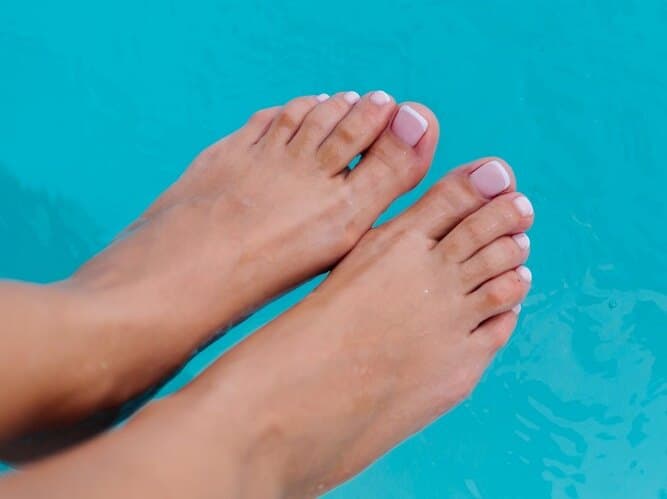Why Do My Feet Turn Purple When I Shower?
Have you ever wondered why your feet turn purple when you shower? It can be a perplexing and alarming experience, but it’s important to understand that there are several reasons why this may occur.
In this article, we will explore the possible causes of why your feet turn purple during showering and discuss ways to alleviate this condition.
Table of Contents
Blood Circulation
Blood vessels play a crucial role in regulating blood flow throughout our body. Arteries carry oxygen-rich blood away from the heart, while veins return oxygen-depleted blood back to the heart.
Efficient circulation ensures that all parts of the body receive an adequate supply of oxygen and nutrients. When circulation is compromised, it can lead to various issues, including changes in skin color.
Read Also: Why Are My Feet Yellow and Cold?
Causes of Purple Feet During Showering
Showering is a daily routine for most of us, and it’s natural to notice changes in our bodies during this time. The phenomenon of feet turning purple can be attributed to a combination of factors:
Temperature Fluctuations
When you expose your feet to hot water, it causes blood vessels in the skin to dilate, increasing blood flow. However, when you switch to cold water, the blood vessels constrict, reducing blood flow and potentially leading to purple discoloration.
Blood Vessel Constriction
Certain individuals may have a condition called vasospasm, where the blood vessels in the feet constrict excessively. This can be triggered by exposure to cold water or even emotional stress, causing purple or blue discoloration.
Medication Side Effects
Certain medications, particularly those affecting blood pressure or circulation, can impact the appearance of the feet during a shower. Consult your healthcare provider if you suspect this may be the cause.
Varicose Veins
Varicose veins are a common condition characterized by swollen, twisted veins. They can lead to poor circulation, potentially causing feet to appear purple during a shower.
Raynaud’s Disease
Raynaud’s disease is a disorder that affects blood circulation, primarily in the extremities. During an episode, the blood vessels narrow, leading to reduced blood flow and discoloration.
Cold temperatures, including cold water during showering, can trigger Raynaud’s disease and result in purple feet.
Peripheral Artery Disease (PAD)
PAD occurs when there is a buildup of plaque in the arteries, restricting blood flow to the extremities. The reduced circulation can cause purple or blue discoloration in the feet.
Deep Vein Thrombosis (DVT)
Deep vein thrombosis, or DVT, is a condition marked by the development of blood clots, usually in the legs. If a clot obstructs blood flow, it can cause discoloration, pain, and swelling.
Diabetes
Individuals with poorly managed diabetes may experience peripheral neuropathy, a condition that damages nerves in the extremities. Reduced blood flow and nerve damage can lead to purple or blue feet.
Check Also: Purple Toe – Causes And Treatment
Prevention of Purple Feet after Shower
Fortunately, there are several remedies and preventive measures you can take to alleviate or minimize the occurrence of purple feet during showering:
Gradual Temperature Transition
To minimize the shock to your circulatory system, start with warm water and gradually adjust the temperature to cooler levels. Avoid rapid changes, as this can help mitigate vasoconstriction.
Incorporate Massage Techniques
Gentle massaging of the legs during and after a shower can promote blood flow and alleviate any potential constriction. Use upward strokes towards the heart to encourage proper circulation.
Elevate Your Legs
Post-shower, take a moment to elevate your legs. This position helps counteract the effects of gravity, aiding in blood flow back to the heart.
Bacterial Factors
Warm and damp environments, such as those created during a shower, can provide an ideal breeding ground for bacteria. If the skin is compromised, either due to small cuts, abrasions, or skin conditions, it becomes more susceptible to bacterial invasion.
To mitigate this risk, ensure that your bathroom and showering area are kept clean and dry. Regularly clean shower mats, curtains, and any surfaces that come into contact with water.
Additionally, be vigilant about personal hygiene, including proper cleansing of the skin. If you notice any signs of infection, such as redness, swelling, or discharge, seek prompt medical attention.
Stay Active
Regular exercise is a cornerstone of good circulatory health. Engage in activities that promote circulation, such as walking or cycling, to maintain optimal blood flow.
Hydrate and Maintain a Balanced Diet
Proper hydration and a balanced diet rich in nutrients are essential for circulatory health. Adequate hydration ensures that blood viscosity remains optimal, while a nutritious diet supports overall vascular function.
Proper Footwear
Wearing well-fitted shoes that provide proper support and insulation can help maintain optimal blood circulation in the feet.
Seek Professional Advice
If purple legs after a shower persist or are accompanied by other concerning symptoms, it’s advisable to consult a healthcare professional. They can conduct a thorough evaluation and provide personalized recommendations.
Conclusion
Purple feet during showering may be a common occurrence, it is generally a benign condition brought about by exposure to warm temperatures. The heat causes the blood in the legs to rise to the skin’s surface, resulting in a purple discoloration.
However, there are simple and effective measures to alleviate this issue. Using cold water, massage techniques, adjusting water temperature, and considering leg compression can all contribute to reducing it.
Moreover, maintaining proper hydration, regular activities and refraining from excessively hot baths or showers, are vital steps in ensuring the continued health and vibrancy of your legs.
By incorporating these practices into your routine, you can enjoy your showers without concern, confident in the knowledge that you’re taking proactive steps towards leg health.
